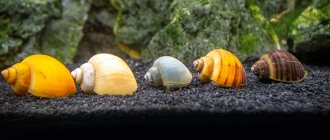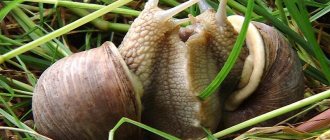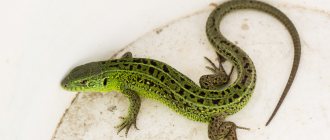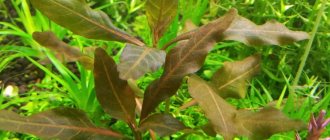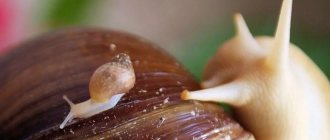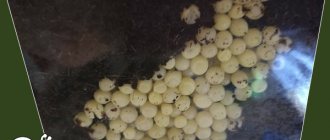Freshwater snails are found in the rivers and lakes of central Russia. These mollusks can be recognized by their large external spiral-shaped shell, from which a leg with a flat bottom surface and a pair of tentacle horns are visible. The size of snails ranges from 5 mm to 6 cm. The river snail either crawls on aquatic plants or sits quietly; it cannot swim. While moving, the snail indiscriminately eats everything that gets in its way.
Aquarium owners often want to diversify their living area and add various pets to it. River snails are no exception in this case, but in order for them to live long and please their owner, they need to create conditions that are as close to natural as possible.
general description
Coils are pulmonate gastropods that live in freshwater. In nature, they are found in open water bodies with moderate currents. In this case, there should be a lot of living plants.
Reel – aquarium snail
Survivability deserves attention. Gastropods survive in any conditions. Even the most aggressive ones. They are able to extract oxygen from water and air. Temperature does not affect life activity. Under unfavorable conditions they hibernate.
Appearance
The shell resembles a spiral. The maximum number of curls is 8 pcs. The curls vary in thickness. The shells are almost transparent. If you look closely, you can see the structure of the body.
Gastropods survive in any conditions
Gastropods pre-stock up on air. It is used to rise to the surface of the water or descend to the bottom. Depending on the type they differ in shade. The color varies from red to brown. Adults grow up to 1-4 cm.
The shell resembles a spiral
They walk on flat feet. They crawl slowly, quite smoothly. Gastropods do not move on the surface of the water. To do this, little mucus is secreted. Breathing involves the lungs. They are located inside the shell. They take up all the free space. On the surface of the head there is a pair of horns.
Habitat
In nature, gastropods are found throughout the planet. Can be found in open shallow water bodies, swamps, lakes, and slow-flowing rivers. Life expectancy is about 3-4 years. In an aquarium - up to 2 years.
Snails - who are they?
Snails belong to the class of gastropods, the most numerous of the types of mollusks. The structure of a snail is a shell, the shape of which depends on the species, and a body. Inside the shell are the internal organs, outside are the head and legs, a means of transportation. The mantle protects internal organs from damage. Aquatic snails may have gills, in which case they breathe oxygen dissolved in water. There are gastropods that breathe atmospheric air; they have one lung.
The structure of the snail. Internal and external organs.
The behavior of snails is most conveniently observed in aquarium conditions. The mollusk extends a leg equipped with mucous glands for ease of movement. Aquarium snails have two tentacles, at the ends of which there are organs of touch that are highly sensitive. The eyes of aquatic gastropods are located at the base of the tentacles, and vision is poorly developed.
Snails can be either hermaphrodite or heterosexual. In the first case, one individual is enough for reproduction. Mollusk shells vary in shape, color and structure. Individuals for an aquarium can be omnivores, herbivores, or carnivores.
An amazing ability of gastropods is the ability to regrow lost parts of the head, tentacles and body.
Types of coils
Coils are classified by type. The most popular types of coil snails are horny and red. Each species differs in behavior, size, shell shape, and shade.
Horny
Hornbills are the largest specimens that can be found in home aquariums. They occupy the bottom of the aquarium and rarely rise higher. Almost all the time they hide in thickets of living plants.
Horn coil
They feed exclusively on the remains of food that remains in the ground. This is due to a poorly developed jaw. Unable to eat solid food. The maximum size is 3.5-4 cm. 5 turns are clearly visible on the shell.
Horny red
The horny red snail coil is practically no different from the ordinary horny snail. The difference is in size. The red species rarely exceeds 2 cm. Many aquarists note that this species cleans the aquarium better than others. In addition, they perform a decorative function.
Red horn coil
Such mollusks look beautiful against the backdrop of living plants of rich green color. They feed mainly on leftover food. If there is a shortage of food, they will not switch to plants.
Far Eastern
The Far Eastern aquarium species can also be found in the aquarium. The difference is the presence of wavy lines throughout the shell.
Snail Coil Far Eastern
In all other respects there are no significant differences from others. Quite unpretentious in content. There is no need to create special conditions. In nature, it can be found mainly in swamps.
Keeled
The keeled snail is much more common than other species. Such gastropods end up in the aquarium by accident. They are brought in with new plants, soil, and decorations.
Snail Coil Keeled
The shell is brown. Adults reach a maximum diameter of 2 cm, while the width does not exceed 0.5 cm. The name was obtained because of the seam it has. You can see it from the outside of the sink. If you look closely at such an individual, it may seem as if it is divided in half. They feed on leftover fish food and fallen leaves.
Wrapped
Wrapped clams are a type of reel. It differs from other species in its shell. The shell is almost transparent. Dirty yellow in color.
Snail Coil Wrapped
Adults grow up to 1 cm in diameter. Envelope gastropods are considered pests of the underwater world. This is due to frequent reproduction and high fertility. In a short period of time they fill the aquarium. If the numbers are not controlled, the water will quickly deteriorate.
How many times should I feed?
If an African Achatina lives in the house, it must be fed and cared for correctly. It is better to feed snails in the evening, because these mollusks are nocturnal creatures and in the evening they become active. For adults, one feeding per day is enough; it is allowed to give them food every other day. Young animals need to have 24/7 access to food. Food should not be placed on the ground so that it does not mix with the substrate and spoil or become moldy. For food you need to use a bowl or, in extreme cases, a lettuce leaf.
Keeping in an aquarium
Land and freshwater species of snails differ in the conditions of their detention. The coils are easy to maintain. There is no need to create special conditions for them. However, if you plan to keep it with other inhabitants of the underwater world, then this is worth thinking about.
What do the coils feed on?
Gastropods do not require a special diet. If there are fish in the aquarium, then you don’t have to worry about anything. They eat the leftover fish food. If there are living plants, they eat dead leaves and dead fish. If targeted breeding is planned, vegetables can be given. They are pre-scalded. Fresh cucumbers, cabbage leaves, lettuce, zucchini, pumpkin, and spinach are suitable.
Conditions of detention
Coil snails in an aquarium do not require special care or maintenance. They are able to adapt to any conditions. Many experienced aquarists recommend maintaining the water temperature between +24 and +28 degrees.
Coil snails in an aquarium do not require special care and maintenance
The shell begins to lose its attractiveness. It is necessary to periodically add calcium to the water. Snails are able to get out of the aquarium. This leads to inevitable death. Therefore, a cover is required.
If an individual dies, it should be pulled out. Otherwise, the water in the aquarium will begin to spoil. The smell of rot emanates from dead individuals.
Reproduction
To breed the coil, no special conditions are required. Mollusks are extremely fertile. Thanks to this, it is easy to get offspring. Coils are hermaphrodites. No other individuals are required for fertilization. If there is at least one mollusk in the aquarium, then after a certain period of time it will begin to reproduce.
Shellfish are extremely fertile
Caviar can be seen on plant leaves, decorations, driftwood, and aquarium walls. After 30 days, small snails will be born. If you provide quality care, you can see results within a few weeks.
Sexual maturity is reached at the age of 12 months. In practice, things are different. Life expectancy in nature is short, so the main goal is to leave as many offspring as quickly as possible.
Attention! The reproduction process is carried out much faster at high water temperatures (from +25 to +28 degrees).
Pros and cons of content
Each aquarist decides for himself whether he needs coils and why. There are benefits to keeping them.
Sexual maturity is reached at the age of 12 months
They clean the aquarium:
- eat leftover food from other inhabitants;
- destroy dead parts of living plants;
- serve as an indicator of water purity.
Some aquarists use it instead of live food for predatory fish.
Despite all the advantages, there is a disadvantage. It cancels out all the benefits. They can reproduce in any conditions. In this case, the process happens quickly. If you don't control their numbers, it will be difficult to get rid of them.
Where to get shellfish
Snails are collected from some fresh water body. Most often they are found on the leaves of algae, the underwater part of stones and driftwood.
When going in search of snails, you should not forget about a container for transporting them and a net of a suitable size. If you plan to collect small representatives of gastropods, you will need tweezers. And large specimens can be taken directly with your hands. In this case, only strong, healthy shellfish without chips or cracks in the shell are selected.
The most common types of snails in our reservoirs are:
- Bithynia tentaculata;
- Common pond snail (Lumnaea stagnalis);
- Viviparous lawnwort (Viviparus viviparous);
- River hole (Theodoxus fluviatilis);
- Spring bladder (Physa fontinalis);
- Dreissena polymorpha;
- Toothless duck and fish (Anodonta anatina).
These species of freshwater inhabitants are quite unpretentious and omnivorous, so they will not cause problems. But you cannot immediately add them to the rest of the inhabitants of the common aquarium. River snails at home must undergo a week-long quarantine. It is placed in a separate container with water. Before this, special antibacterial substances are added to the water. You can buy them at your nearest pet store.
The benefits and harms of coils
Whether coils are beneficial or harmful is of interest to many aquarists. They are unpretentious. Capable of performing useful functions in an aquarium.
Provided that the number is small:
- Decorative. The snail coils are quite beautiful. Can be kept with small fish. In harmony with the underwater world. Saturate the aquarium with additional colors.
- Sanitary. Dead parts of plants are used as food. They do not touch healthy leaves. They also eat food from other inhabitants. Capable of removing film formed on the surface of the water and the walls of the aquarium.
- A kind of indicator of water quality. If the snails in the aquarium begin to multiply rapidly, you should think about it. Most often, this is a signal that it is time to clean the soil and do a water change. At the same time, the amount of food given to the fish is reduced.
- Live food for others. Some types of fish consume gastropods as food, eat young snails, and clean off eggs.
Snail coils are quite beautiful
In addition to their benefits, shellfish can cause significant harm.
Among the main reasons to remove them from the aquarium are:
- Reproduction rate. If you do not monitor the number of individuals, the population will soon become huge. As a result, other occupants will experience discomfort.
- Lack of food. If the quantity is large, food shortages may occur. So they can move on to plants.
- Carriers of infectious diseases. Wild snails that accidentally enter an aquarium can cause a number of diseases. This leads to the death of fish.
- Appearance. With uncontrolled reproduction, mollusks will occupy all surfaces of the aquarium. The content from waste products will rarely increase.
The coil snail is a hermaphrodite. A second individual is not required for reproduction. If you get several mollusks, after a while they will multiply into a whole group. Caviar in appearance resembles a transparent film with small black dots. The ripening process lasts a month. Then small snails are born.
Attention! The eggs of coil snails can be found anywhere - on plants, driftwood, decorations, and the walls of the aquarium.
Methods of disposal
The reproduction of coils in an aquarium must be controlled.
Coil snail – hermaphrodite
You can get rid of them in several ways:
- Buy ancistrus. The catfish sucker actively cleans any surface in the aquarium. As a result, he removes the eggs. Before you get rid of shellfish, it is worth understanding whether coil snails are a harmful inhabitant;
- Get a dwarf tetradon. This type of fish feeds exclusively on mollusks. Before moving in, you should study information about compatibility with other residents;
- Buy helen snails. Such mollusks are considered predators. They are capable of completely exterminating the entire population of coils;
- Self-removal. To do this, place a scalded cabbage leaf or banana peel, which has already darkened, on the bottom of the aquarium. When the snails completely adhere to the leaf, it is immediately removed;
- Use of chemicals. These products are sold in specialized stores. If possible, the fish are placed separately. After this, you will most likely have to restart. This is due to changes in water parameters.
The most effective method is a complete restart. The walls of the aquarium are doused with boiling water, the soil and decorative elements are boiled. The coil snails in the aquarium will be hatched 100%.
Breeding
Sex differences
There are no gender differences, since pond snails are hermaphrodites, that is, they are endowed with both female and male genital organs.
Getting offspring
Representatives of this species are hermaphrodites; reproduction can occur either alone or in groups. Pond snail eggs can be found on the foliage of aquarium plants. The eggs are held together by mucus and form an oval pouch. Under favorable conditions, one individual can lay up to 25 such sacs in 4 months. Each clutch contains up to 80 eggs. The eggs are small in size and colorless (transparent). One month after fertilization, small snails hatch. Pond snails reach sexual maturity at 6-8 months. Small pond snails reproduce very actively; to develop a stable population, it is recommended to thoroughly wash the aquarium plants to get rid of excess clutches. Throughout their life cycle, pond snails reproduce up to 500 times.
Myths about reels
The benefits and harms of snail coils are a point that causes controversy among aquarists. Reels are considered the most popular aquarium clams. It is for this reason that many myths are born around them.
Aquarium snail coils do more good than harm
Among which:
- Shellfish harm healthy plants. This is a myth. Snails have a rather poorly developed jaw. Therefore, they cannot destroy hard plant leaves and algae.
- Coils carry a large number of infectious diseases. There is some truth here. However, it should be borne in mind that disease carriers are wild specimens that accidentally entered the aquarium. For this reason, it is recommended to purchase all livestock from pet stores. Withstand quarantine.
- Reproduction. This is true. In the absence of predators that feed on shellfish, reproduction occurs quickly. It is recommended to monitor the population.
Reels are considered the most popular aquarium shellfish
Aquarium snail coils do more good than harm. But this requires monitoring their population. Avoid overbreeding.
Why are river mollusks dangerous?
River snails are potential carriers of helminths and other parasites that can cause fish diseases.
When only guppies live in the aquarium, you can place river snails there without much fear. And if the population of a home reservoir is more susceptible to external factors, it is better not to risk it and keep the mollusks separately.
Photo and video
You can see what different types of coils look like in the photo. If you plan to breed yourself, you can watch the video. From informational videos you can learn how they live, reproduce, and move.
Nutrition
The frequency of feeding depends on the age of the mollusk. Small representatives require feeding several times a day, while adults are fed once every 1–2 days. The pet can go without food for up to 2 weeks, but you should not abuse this.
The daily diet of snails mainly consists of vegetables, fruits and vegetation. We wrote more about snail nutrition separately.
Authorized products:
- Vegetables (tomatoes, cucumbers, cabbage).
- Fruits (bananas, apples).
- Leaves (grape, dandelion, spinach, lettuce).
- Berries (strawberries, wild strawberries, raspberries).
- Oatmeal, bran.
- Protein feeding 1-2 times a week (gammarus, daphnia).
What not to feed:
- Spicy.
- Roast.
- Smoked.
- Sweet.
- Salty.
- Citrus (oranges, lemons, tangerines).
- Pasta.
- Bread.

